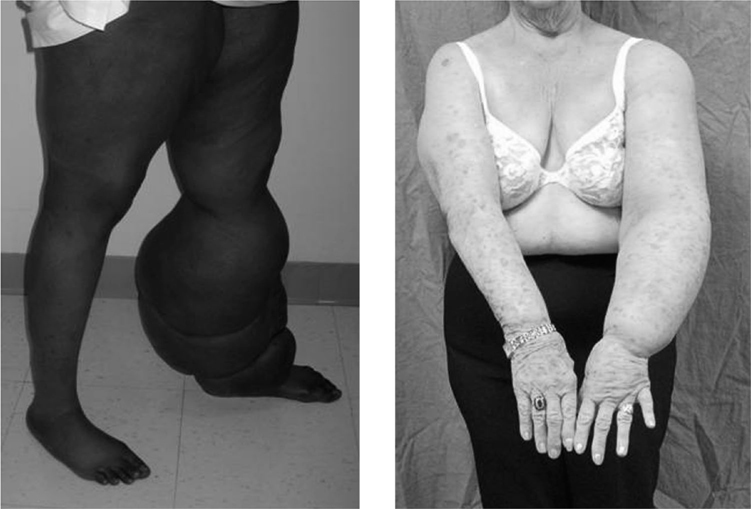What is lymphedema?
Accumulation of protein-rich fluid in the interstitial space due to lymphatic dysfunction.
 How common is lymphedema?
How common is lymphedema?
Approximately 150 million people are affected worldwide.
 What structures are most commonly involved?
What structures are most commonly involved?
The extremities, followed by the genitalia.
 Does lymphedema affect the superficial or deep areas of the extremity?
Does lymphedema affect the superficial or deep areas of the extremity?
Only the subcutaneous tissues are involved.
 What is the natural history of lymphedema?
What is the natural history of lymphedema?
Adipose and fibrous tissues are produced which cause enlargement of the limb.
Primary or secondary.

Types of lymphedema. (Left) A 24-year-old female developed primary lymphedema of the lower extremity during adolescence. (Right) A 70-year-old female with upper extremity lymphedema following mastectomy, axillary lymphadenectomy, and radiation for breast cancer.
 What is primary lymphedema?
What is primary lymphedema?
Lymphedema that results from a congenital malformation of the lymphatic system.
 How common is primary lymphedema?
How common is primary lymphedema?
Rare. The prevalence is approximately 1:100,000.
 When does primary lymphedema present?
When does primary lymphedema present?
Males usually present in infancy, females typically develop swelling in adolescence.
 What structures are most commonly affected by primary lymphedema?
What structures are most commonly affected by primary lymphedema?
Lower extremities (90%), genitalia (16%), and upper extremities (10%).
 Is there a genetic cause of primary lymphedema?
Is there a genetic cause of primary lymphedema?
Yes, mutations in VEGFR3, FOXC2, SOX18, and CCBE1 cause some familial/syndromic forms of lymphedema.
Lymphedema of one or both lower extremities present at birth, with either a family history of disease or a mutation in VEGFR3.
 What is Meige disease?
What is Meige disease?
Lymphedema of one or both lower extremities presenting in adolescence with a family history of the disease; a genetic mutation has not been identified.
 What is secondary lymphedema?
What is secondary lymphedema?
Lymphedema that results from injury to the lymphatic system.
 What is the most common cause of lymphedema worldwide?
What is the most common cause of lymphedema worldwide?
Parasitic infection (filariasis), causing lower extremity lymphedema.
 What is the most common cause of lymphedema in developed countries?
What is the most common cause of lymphedema in developed countries?
Upper extremity lymphedema secondary to axillary lymphadenectomy and radiation treatment for breast cancer.
 What percentage of women with breast cancer who have axillary lymphadenectomy and radiation develop lymphedema?
What percentage of women with breast cancer who have axillary lymphadenectomy and radiation develop lymphedema?
Approximately 33%.
Stay updated, free articles. Join our Telegram channel

Full access? Get Clinical Tree


 How is lymphedema classified?
How is lymphedema classified? What is Milroy disease?
What is Milroy disease?